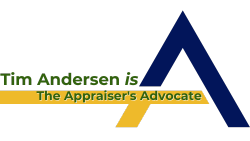QUESTION: This is another highest and best use question. I check the box on p. 1 of the URAR. In the narrative addendum I include highest and best use boilerplate I got from another appraiser. Why are reviewers dumping on me about highest and best use? The subject property is a house in a neighborhood full of other houses. They all have residential zoning. There is no indication the zoning is about to change. Nobody is buying houses to raze them and then redevelop the underlying site. What, please, is the big deal about highest and best use?
The short explanation is that the reviewer thinks your summary of the support and rationale for your highest and best use conclusion you present in the report is incomplete [see USPAP’s SR2-2(a)(x)]. Therefore, quickly and precisely explain how you went thru each one. When you get to financially feasible:
“My analysis indicates it would not be financially feasible in this market to purchase the subject and its improvements for their market value, raze the improvements, improve the then-vacant site to its highest and best use as if vacant, and then try to sell that new property. There would be no profit potential in such a scenario. Therefore, the present improvements in their current condition are the site’s highest and best use as improved”
If you choose to make such a comment in your report, please have market support for this statement in your workfile.
It is true that your conclusions of highest and best use of the site as if vacant, as well as improved, are opinions you develop from your analyses of market data, not facts you merely find. However, to conclude a site value (as if vacant and available, etc. – which you must do if you complete the cost approach, or if the client demands it) means you have analyzed the market to determine the highest and best use of the vacant site.
Remember that, by definition, the highest and best use of the vacant site is the one that brings it the highest value. When you state in the cost approach the value of the vacant site is $XXXXX, the implication is you have engaged in two (2) separate analyses to find those vacant site sales that have the same highest and best use as the subject (otherwise, by definition, they are not comparable). Then, the second analysis is the process by which you discover the salient differences between the subject and the comps in order to adjust the comps for those differences.
It is true the 1004 form states, “COST APPROACH TO VALUE (not required by Fannie Mae). Nevertheless, this does not mean the appraiser avoid the analyses of the cost approach. Rather, the appraiser does not need to include the cost approach in the report. A wise appraiser still engages in the analytics of the cost approach (1) to conclude a site value as if vacant; (2) allocate depreciation [after extracting it from the market] to its three sub-components; and (3) to determine if there is an entrepreneurial incentive or profit in the market.
Listen to the market. What does the Cost approach tell you? If this value indication is the highest of the three approaches, these improvements, even after depreciation, are not the highest and best use of the site as vacant because they cost more than their contributory market value. If these improvements were new, the Cost approach would tell you the highest and best use of the site as if vacant would be to leave it vacant. Why? Would you buy a lot and build a house on it at a total of $1,000,000, if the house/site had a market value of only $800,000?
What else does the Cost approach tell you? If you chose not to include an entrepreneurial incentive or profit (EI/P) in the cost approach, then you have just said there is not one in the market. This is one sure sign of an external obsolescence factor, a sure sign the market is about to change, and probably not for the positive. To omit an EI/P is essentially the same as putting in a zero (-0-). So, if you leave it out, there must be an explanation as to why. To note a lack of an EI/P is also a sign the highest and best use of a vacant property is let it remain vacant until such time as the market changes.
